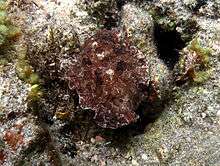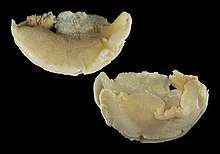Tayuva lilacina
Tayuva lilacina is a species of sea slug, a dorid nudibranch, shell-less marine gastropod mollusks in the family Discodorididae.[2] A number of species descriptions are considered to be synonyms.[4]
| Tayuva lilacina | |
|---|---|
 | |
| Scientific classification | |
| Kingdom: | |
| Phylum: | |
| Class: | |
| (unranked): | |
| Superfamily: | |
| Family: | |
| Genus: | Tayuva |
| Species: | T. lilacina |
| Binomial name | |
| Tayuva lilacina | |
| Synonyms[2] | |
| |
Distribution
This species was described from Honolulu, Oahu, Sandwich Islands. It has been reported widely in the Indo-Central Pacific and from the Pacific coast of Mexico and the Canary Islands. This wide distribution suggests that it is probably a species complex, but it has been considered to be an invasive species.[5]
Description
The maximum recorded body length is 50 mm[6] or up to 120 mm.
Ecology
Minimum recorded depth is 0.5 m.[6] Maximum recorded depth is 63 m.[6]
Tayuva lilacina feeds on Haliclona caerulea according to the in situ observations on the Pacific coast of Mexico.[7] It is probably highly specialized on this sponge.[7]
References
- Gould A. (1852). Mollusca and Shells [in]: United States Exploring Expeditions, 1838, 1839, 1840, 1841, 1842 under the command of Charles Wilkes, U.S.N.. Philadelphia, C. Sherman & son : vol. 12, xv + 510 pp., page(s): 297-298
- Bouchet, P. (2011). Tayuva lilacina (Gould, 1852). Accessed through: World Register of Marine Species on 2011-08-23.
- Ballesteros M., Llera E. M. & Ortea J. (1985). Revision de les Doridacea (Mollusca: Opistobranchia) del Atlantico nordeste atribuibles al complejo maculosa-fragilis. Bollettino Malacologico 20 (9-12): 227-257.
- Dayrat B. 2010. A monographic revision of discodorid sea slugs (Gastropoda, Opisthobranchia, Nudibranchia, Doridina). Archived 2015-09-08 at the Wayback Machine Proceedings of the California Academy of Sciences, Series 4, vol. 61, suppl. I, 1-403, 382 figs.
- Streftaris, N.; Zenetos, A.; Papathanassiou, E. (2005). Globalisation in marine ecosystems: the story of non-indigenous marine species across European seas. Oceanogr. Mar. Biol. Annu. Rev. 43: 419-453
- Welch J. J. (2010). "The “Island Rule” and Deep-Sea Gastropods: Re-Examining the Evidence". PLoS ONE 5(1): e8776. doi:10.1371/journal.pone.0008776.
- Verdín Padilla C. J., Carballo J. L. & Camacho M. L. (2010). "A qualitative assessment of sponge-feeding organisms from the Mexican Pacific Coast". Open Marine Biology Journal 4: 39–46. PDF Archived 2016-10-27 at the Wayback Machine
Further reading
- Keen M. (1971). Sea shells of Tropical West America. Marine mollusks from Baja California to Perú. (2nd edit.). Stanford University Press pp. 1064
- Gofas, S.; Le Renard, J.; Bouchet, P. (2001). Mollusca, in: Costello, M.J. et al. (Ed.) (2001). European register of marine species: a check-list of the marine species in Europe and a bibliography of guides to their identification. Collection Patrimoines Naturels, 50: pp. 180–213
- Burn R. (2006) A checklist and bibliography of the Opisthobranchia (Mollusca: Gastropoda) of Victoria and the Bass Strait area, south-eastern Australia. Museum Victoria Science Reports 10:1–42.
External links
- "Tayuva lilacina". Gastropods.com. Retrieved 16 January 2019.

- Photos of Tayuva lilacina on Sealife Collection